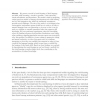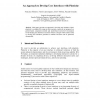76 search results - page 14 / 16 » What is the next generation of human-computer interaction |
ALIFE
2010
13 years 6 months ago
2010
We present a model of social learning of both language and skills, while assuming—insofar as possible—strict autonomy, virtual embodiment, and situatedness. This model is built...
ACMDIS
2006
ACM
14 years 1 months ago
2006
ACM
One challenge for ubiquitous computing is providing appropriate tools for professional designers, thus leading to stronger user-valued applications. Unlike many previous tool-buil...
DSVIS
2003
Springer
14 years 1 months ago
2003
Springer
This paper provides an approach to develop user interfaces where plasticity is considered by using several concepts, concretely our proposal is a pattern-based, component-oriented ...
ECAI
2000
Springer
14 years 5 days ago
2000
Springer
There are two major approaches to activity coordination in multiagent systems. First, by endowing the agents with the capability to jointly plan, that is, to jointly generate hypot...
ICDM
2009
IEEE
14 years 2 months ago
2009
IEEE
—The real world is composed of sets of objects that move and morph in both space and time. Useful concepts can be defined in terms of the complex interactions between the multi-...


